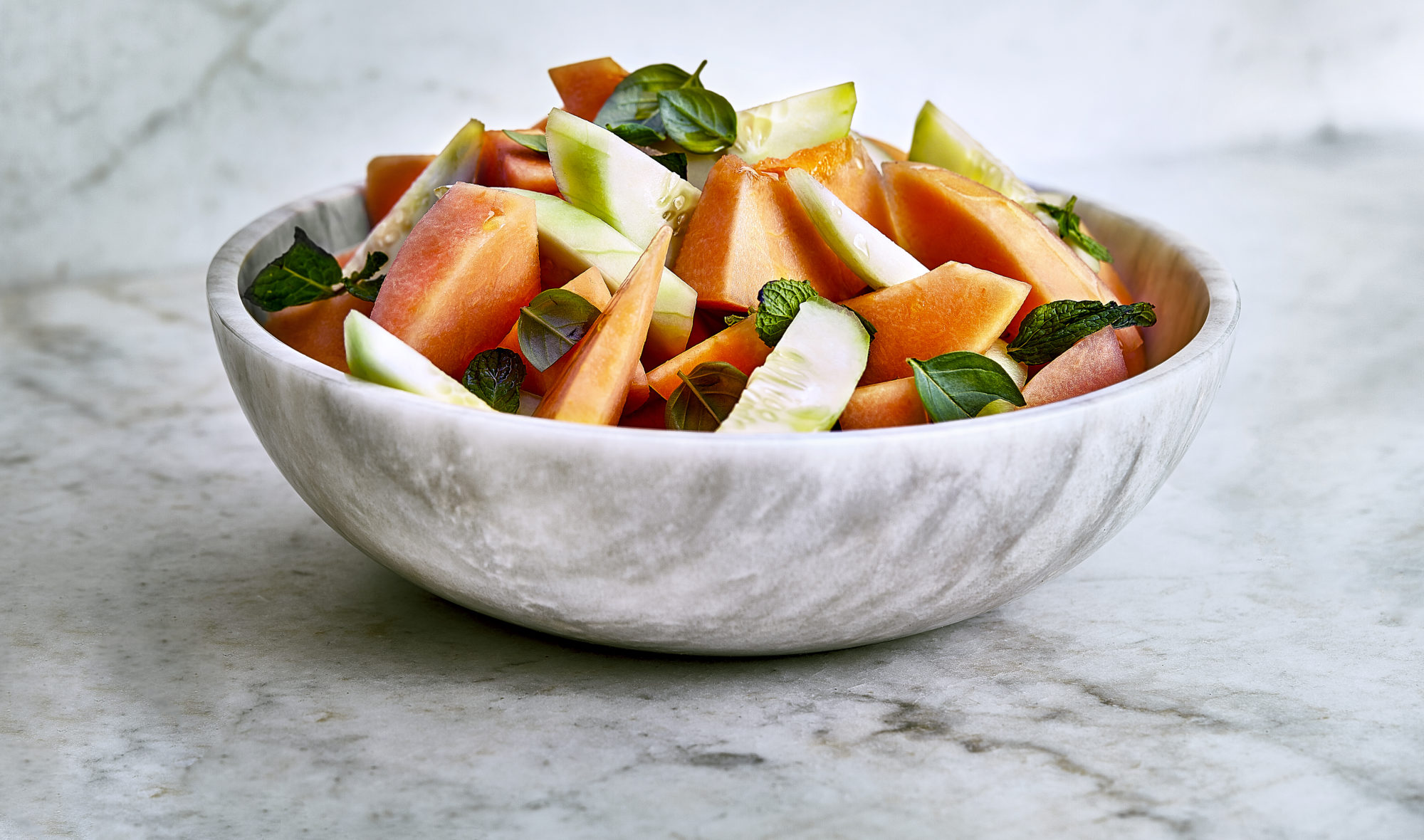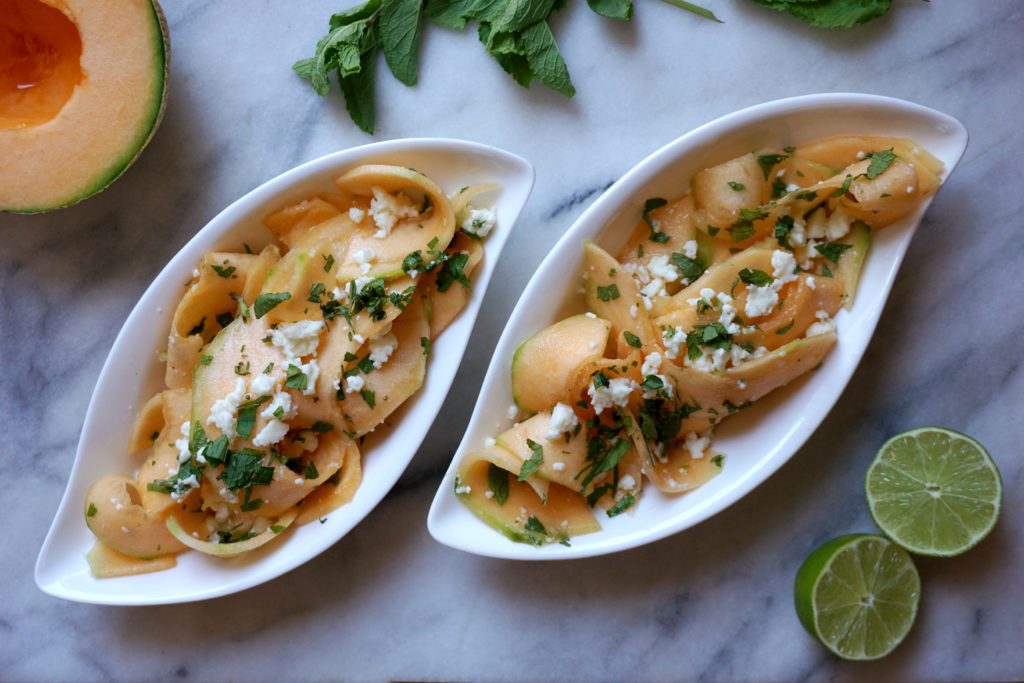Cantaloupe


With its greyish scaly skin, cantaloupes look like zombies of the fruit world. But don’t be deceived, as this fruit bears a vitamin C-rich, sweet and juicy sunset-colored flesh whose deliciousness betrays its homely outer appearance. Like other melons, cantaloupes grow on vines and are often picked and shipped out before they are fully ripened, so when shopping for a ripe cantaloupe, be sure to look for the following qualities: A ripe and juicy cantaloupe will be heavy for its size; will have a slightly yellowish or cream-colored (rather than greenish or grey) rind; will smell slightly sweet and musky; and will have flesh that yields to light pressure. Due to risk of microbial contamination, it is recommended that caution is taken when preparing and storing your cantaloupe. Most important is to rinse your cantaloupe before slicing, and keeping it refrigerated after slicing. Once it’s in your belly, you can just relax and let digestion do its work.
Whether you’ve encountered it unfussy and undressed on a simple fruit platter, or fancied up and draped in prosciutto, cantaloupe is a delicious fruit you will be delighted to put in your mouth.
In terms of outer appearance, with their scaly, greyish skin, cantaloupes are the zombies of the fruit world. However, rest assured: Inside, they are sweet, smooth, sunset-colored, and juicy. It is likely these inner attributes that make cantaloupes the US’s most popular melon!
Cantaloupes are part of the Curcubitaceae family, which also includes cucumber, zucchini, and other squash.
Like its cousins, cantaloupes grow on vines. Once they are picked, cantaloupes are often washed with bleach or sodium hypochlorite prior to shipping. This step is performed because cantaloupe skin is particularly prone to bacterial contamination and mold. Due to this concern, it is also recommended that the surface of a cantaloupe is rinsed and scrubbed well before cutting and serving.
Currently, China is the world’s top producer of cantaloupes, with Turkey, Iran, and Egypt following as prolific cultivators.
Cantaloupes are large and hefty round fruits – a medium cantaloupe will weigh around five pounds and be about five to six inches in diameter.
Cantaloupe is covered by a decidedly unattractive skin – a greyish-beige, rough, net-like pattern covers a green base that yellows as the fruit ripens.
Inside, the cantaloupe bears a beautiful pale pinkish-orange flesh and a center full of seeds and mush, which can be scooped out before the fruit is eaten*. This fruit is juicy and has a sweet, floral, and slightly musky flavor.
*While the seeds and mush are perfectly edible, they are typically discarded as waste. However, in some cultures, roasted cantaloupe seeds are a popular snack. Try them yourself by rinsing them, patting them dry, and then toasting them until golden brown with a little bit of olive oil in a skillet. Season with salt and spices, and eat.
One cup of cubed cantaloupe (about 160g) has 54 calories, 1.3g protein, 0.3g of fat, 13.1g of carbohydrates, 1.4g fiber, and 12.6g sugar. Cantaloupe is an excellent source of vitamin C and beta carotene.
Cantaloupes are available all year-round at most grocery stores, although in North America, they will likely taste best in the summer when they are available from more local sources.
When choosing a tasty, ripe cantaloupe, look for specimens that are heavy for their size and those that have creamy-colored or yellowish rinds. Cantaloupes with green or grey rinds are more likely to be unripe.
Find the stem end of the fruit and press your thumb gently into it. An overripe cantaloupe will feel very soft and squishy, and an underripe one will feel very hard. A cantaloupe that is perfectly ripe will yield slightly to gentle pressure.
Lastly, smell that melon! A ripe cantaloupe will smell cantaloupe-y and slightly musky. No smell at all likely means it is underripe. A very strong, or even alcoholic smell will mean it is overripe.
Caution should be taken in storing your cantaloupe due to risk of bacterial and / or fungal contamination.
Before cutting, an optimally ripe cantaloupe can be stored in the fridge for three to four days. (If it hasn’t ripened fully, it can be stored at room temperature until it begins to exhibit some signs of ripening – yellowing, smelling sweet, and softening slightly.)
After cutting, due to risk of contamination by microorganisms, public health organizations recommend that cantaloupe not be left out at room temperature for more than two hours. It is suggested that cantaloupe left out beyond this time be discarded.
Otherwise, freshly cut cantaloupe can be stored in an airtight container for two to three days, or in the freezer for up to six months.
Again, due to the risk of bacterial and / or fungal contamination, caution should be taken when preparing your cantaloupe.
First, wash your hands and all kitchen tools you’ll be using to prepare your melon. Then, rinse the whole cantaloupe under cool running water, gently scrubbing the rind with a fruit / vegetable brush, then pat the skin dry with a clean kitchen towel. Next, using a clean sharp knife, cut off the very top of the stem end, and discard (bacterial contamination is most likely to occur in this spot). Slice the cantaloupe in half, and then scoop out the seeds and mush and discard those as well, unless you will be using the seeds to roast. Cut your cantaloupe in whatever size slices you like, removing the rind before consuming. Alternatively, you can also cut the fruit in cubes, or use a melon baller tool to create cute little cantaloupe spheres. And then, eat it up.

This simple salad takes minutes to put together, and makes an elegant, unexpected side. Sweet and juicy cantaloupe combines with savory feta and fresh mint for a satisfying dish.
Prep Time: 10 minutes Cook Time: 0 minutes Yield: 2 servings
Once the rind of the cantaloupe is removed and the seeds are scooped out, slice the melon into thin ribbons. To do this, use a very sharp knife, or better yet, a mandolin.
Next, place ribbons in a large bowl, and add mint and lime juice. Toss to combine.
Portion into individual bowls, then top with crumbled feta, a drizzle of good quality olive oil, and if you desire, a few cracks of fresh pepper.
Serve immediately. Enjoy!
Precision Nutrition’s Encyclopedia of Food expands every single month as we highlight new foods and showcase beautiful food photography. If you’d like to stay up to date, simply click this link. From there, we’ll send you a FREE copy of our recipe book. We’ll also let you know when new and delicious foods are added to the site.
With its greyish scaly skin, cantaloupes look like zombies of the fruit world. But don’t be deceived, as this fruit bears a vitamin C-rich, sweet and juicy sunset-colored flesh whose deliciousness betrays its homely outer appearance. Like other melons, cantaloupes grow on vines and are often picked and shipped out before they are fully ripened, so when shopping for a ripe cantaloupe, be sure to look for the following qualities: A ripe and juicy cantaloupe will be heavy for its size; will have a slightly yellowish or cream-colored (rather than greenish or grey) rind; will smell slightly sweet and musky; and will have flesh that yields to light pressure. Due to risk of microbial contamination, it is recommended that caution is taken when preparing and storing your cantaloupe. Most important is to rinse your cantaloupe before slicing, and keeping it refrigerated after slicing. Once it’s in your belly, you can just relax and let digestion do its work.